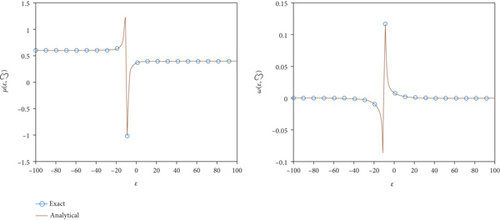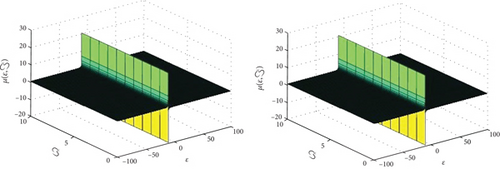Fractional-View Analysis of Jaulent-Miodek Equation via Novel Analytical Techniques
Abstract
In this article, we analyze the analytical result of fractional-order Jaulent-Miodek equations with the help of two novel methods, namely, ρ-Laplace decomposition method and ρ-Laplace variational iteration method. The achieved results are shown in a series form, which is rapidly converging. The approximate simulations were performed in absolute error to ensure that the suggested methods are accurate and reliable. The achieved results are graphically presented to confirm the validity and accuracy of the techniques. The study results reveal that the ρ-Laplace decomposition method is computationally very effective and accurate compared to ρ-Laplace variational iteration method to analyze the nonlinear system of fractional-order Jaulent-Miodek equations.
1. Introduction
The nonlinear system JM equation has been analyzed in past years by several researchers through different methods like homotopy perturbation transform method [7], optimal homotopy asymptotic method and Hermite wavelets [8], invariant subspace technique [9], and others [10–12].
Systems of nonlinear partial differential equation [13–17] appear in a variety of scientific physical models. The classical Jaulent-Miodek equations have been the subject of extensive investigation in recent years. Several techniques such as suitable algebraic technique [18], Adomian decomposition technique [19], tanh-sech technique [20], homotopy perturbation technique [21], Exp-function technique [22], and homotopy analysis technique [23] had been applied for solving of the system of Jaulent-Miodek equations. But the complete evaluation of the nonlinear fractional-order combined with the Jaulent-Miodek equation is only an initiation by the available information.
Abdeljawad and Jarad [24] recently developed the Laplace transform of the fractional-order Caputo derivatives. We proposed a new iterative technique based on the ρ-Laplace transformation to study fractional-order ordinary and partial differential equations with fractional-order Caputo derivatives. This novel proposed method is used to solve numerous fractional-order differential equations, including linear and nonlinear diffusion equations, fractional-order Fokker-Planck equations, and Zakharov-Kuznetsov equations [25–27]. Adomian, an American mathematician, introduced the Adomian decomposition method. It concentrates on obtaining series-like solutions and decomposing the nonlinear operator into a sequence, with the terms currently obtained using Adomian polynomials [28–31]. The ρ-Laplace transform is used to modify this procedure, resulting in the ρ-Laplace decomposition method. This method is applied to the nonhomogeneous fractional differential equations [32–34]. He [35, 36] was the first to introduce the variational iteration method (VIM), which was successfully applied to autonomous ordinary differential equations in [37], nonlinear polycrystal line solids in [38], and other fields. The variational iteration method is modified with the help of ρ-Laplace transform, known as ρ-Laplace variational iteration method. Different types of ODEs and PDEs have been analyzed with the aid of the variational iteration method. For instance, this method is investigated for solving fractional differential equations in [37]. In [38], this method is used to solve nonlinear oscillator equations. Compared to the Adomians decomposition method, variational iteration transforms approach solving without the need to compute Adomian’s polynomials. The [39] mesh point procedures provide an analytical solution, whereas this scheme provides a fast response to the equation [40–42]. This technique can also be used to approximate accurate results.
This article has applied the ρ-Laplace decomposition method and ρ-Laplace variational iteration method to solve the fractional coupled Jaulent-Miodek equation with the Caputo fractional derivative operator. The analytical results attained via the ρ-Laplace decomposition method were compared with exact results and those derived by using the ρ-Laplace variational iteration method in case of fractional order.
2. Basic Preliminaries
2.1. Definition
2.2. Definition
2.3. Definition
2.4. Definition
2.5. Definition
3. The Methodology of ρ-Laplace Decomposition Method
where is the Caputo fractional derivative of order ϑ, , , and , are linear and nonlinear functions, respectively, and and are source operators.
4. The Producer of ρ-LVITM
5. Implementation of Techniques
5.1. Problem
The nonlinear terms find with the help of Adomain polynomials
The approximate solution by ρ-LVIM.
In Figure 1, the first figure shows the ρ-Laplace decomposition method and ρ-Laplace variational transform method and exact solutions graphs of the given problem at and . From the given graphs, it can be observed that both the exact, ρ-Laplace decomposition method, and ρ-Laplace variational transform method solution are in strong agreement with each other. In Figure 2, the exact and approximate solution of at ϑ = 1. Figure 3, different fractional-order of ϑ = 0.8 and 0.6 of the model. Similarly, in Figure 4, the exact and approximate solution of at ϑ = 1. Figure 5, different fractional-order of ϑ = 0.8 and 0.6 of the model. It is investigated that results of fractional-order problem are convergent to an integer-order result as fractional-order analysis to integer-order. The same phenomenon of convergence of fractional-order solutions towards integral-order solutions is observed.





6. Conclusion
In this paper, two analytical methods are applied to solve fractional-order nonlinear Jaulent-Miodek equation. The analytical results of the equations are calculated to show the reliability and validity of the suggested techniques. Figures of the results are plotted to show the closed contact between the achieved and exact solutions. Moreover, the proposed methods provide easily computable components for the series-form solutions. It has been discovered that the results obtained in series form have a better rate of convergence to the exact solutions. Finally, the proposed strategies are found to be a sophisticated strategy for solving various fractional-order nonlinear partial differential equations.
Conflicts of Interest
The authors declare that there are no conflicts of interest regarding the publication of this article.
Authors’ Contributions
Ahmad Haji Zadeh and Nehad Ali Shah contributed equally to this work and are the co-first authors.
Acknowledgments
This research was supported by Basic Science Research Program through the National Research Foundation of Korea (NRF) funded by the Ministry of Education (no. 2017R1D1A1B05030422).
Open Research
Data Availability
The numerical data used to support the findings of this study are included within the article.




